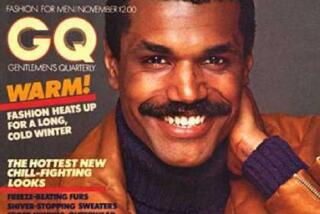Guys Want to Look Good Too : Fashion Has Become the Top Story in Men’s Magazines
- Share via
NEW YORK — For the fashion-conscious male, it’s been a long drought. But after decades of being ignored by most style magazines, there is a new wave of publications covering the masculine side of the art of dressing.
With new titles such as P.O.V., Maxim, Icon and Dossier all poised to pick up readers where more traditional magazines leave off, there is a bold generation of publishers who want to be the prime source of real stuff for real guys.
As the new mags struggle to be seen and heard, icons such as Details and Esquire are engaged in their own highly publicized revamps, installing new editorial teams and fresh fashion coverage. Even Men’s Journal, that hulky purveyor of biking and biceps, is embracing fashion.
Magazines are not as easy to categorize as they may seem. But, generally, those directed to men contain some combination of these elements: sport, music, money, fashion, technology, fitness and women.
There are any number of formulas, allowing the field to cover such seemingly diverse titles as Playboy, Men’s Health and GQ. Even those three tend to share a certain recipe for success: a money column here, a naked woman there, ab exercises in between.
Beyond features, the magazines share an advertising bond. In each publication you’ll find the Tommy Hilfigers, Gaps, Chryslers and Budweisers. But more and more, it’s the former two--the fashion ads--that publishers are most anxious to attract.
“Right now, fashion is 30% of our [ad] base and will end up being more than half,” says Drew Massey, publisher of the 3-year-old P.O.V. Playboy Publisher Richard Kinsler says fashion advertising is “absolutely essential.” The same goes for younger publications such as Vibe and Spin, music magazines with mostly male audiences. There, fashion accounts for more than 50% of all advertising, says John Rollins, publisher for both magazines.
But why the sudden surge of new titles and editorial relaunches? As for the new magazines, it’s simple. Publishers want a piece of an advertising base with lots of money to spend. And they see an opening in the marketplace for accurate, service-oriented fashion coverage.
“Our purpose is not to take ourselves too seriously or to be another insipid fashion magazine,” Massey assured P.O.V. readers last month. “We [want] to sift through the hype and deliver the classic style that helps you look and feel good.”
Such an approach is the right one for men’s mags, says Paul Wilmot of Wilmot Communications and former Conde Nast executive. “Men want service. They want their needs addressed in an intelligent way. Period.”
Men also need advice, says industry analyst David Wolfe, creative director of the Doneger Group. “There’s a major opportunity out there for a how-to book. How long should a collar be? How do I tie a bow tie? The world is not bounded by Gucci on one side and Armani on the other.”
Each magazine has its own editorial voice, which is used to shape articles, select contributors and sign advertisers. Sometimes, the voice is at odds with the publication’s fashion coverage. Some fashion editors would rather dictate trends than read them. And since publishing is a business, there is also an interest, spoken or un-, in assuaging advertisers.
Even the mighty GQ and Details, Conde Nast’s patriarchs of men’s fashion, can seem out of sync with the “real” coverage Wolfe speaks of. GQ boasts of its wealthy, educated, white-collar readership, but how many Wall Street types or Orange County lawyers have the hubris to wear Comme des Garcons suits, Missoni sweaters and Prada boots? It’s a blue-suit, white-shirt, red-tie audience--Brooks Brothers, not Fred Segal. Does the cutting-edge Details demographic buy the oft-featured Dolce & Gabbana trousers and John Bartlett coats or turn to Levi’s jeans and Gap shirts instead?
*
Vogue, Harper’s Bazaar and W are considered by some in the trade to be aspirational magazines--many of their readers, whatever their size, shape or bank account, enjoy seeing beautiful photographs of beautiful clothes on beautiful women. But many readers of men’s magazines, says menswear designer Gene Meyer, are different. “Most men get their fashion direction from peer groups, from friends, someone at work.”
But editors are working to make their fashion coverage more “accessible,” says Michael Caruso, new editor of Details. “I want the reader to be able to do the things the models in the shoots are doing and buy the things they’re wearing.”
At Spin magazine, fashion director Jill Swid looks at clothes the way the magazine looks at issues. “I don’t shoot a story based on fashion trends. I shoot it on cultural issues and scene happenings; I try to mirror our reader’s lifestyle. Every Spin reader purchases sneakers and jeans, so that’s a huge part of my stories.” Similarly, Men’s Journal is sure to showcase hiking chic and ski slope suave.
It doesn’t hurt that the reader men’s magazines want to attract is more fashion-conscious than ever. He’s fit, healthy, even slightly vain. He’s concerned with his appearance and putting more effort into his clothing decisions. Yet, he’s not the married, Volvo-driving suburbanite with two kids and a dog so loved by publishers and advertisers. It’s the younger, non-corporate, often non-white male who is driving trends in fashion.
Call him what you may: urban, street, Euro--he’s the one buying brand name designer fashions. Gay-oriented Out magazine’s readership is very fashion-forward and, according to industry analysts, spends more on clothing than typical readers of more traditional men’s publications. The music-centered Vibe readership has a similar profile. “It’s about imaging and branding,” says Rollins. “The urban music enthusiast wants to be seen in Armani and Versace along with Phat Farm and Nike in a way that says, ‘I’m cool.’ ”
For the casually fashionable man to the clueless fashion victim, the current state of men’s publishing brings a welcome change: choice. With so many magazines, he’s almost guaranteed to find one that speaks his name.






